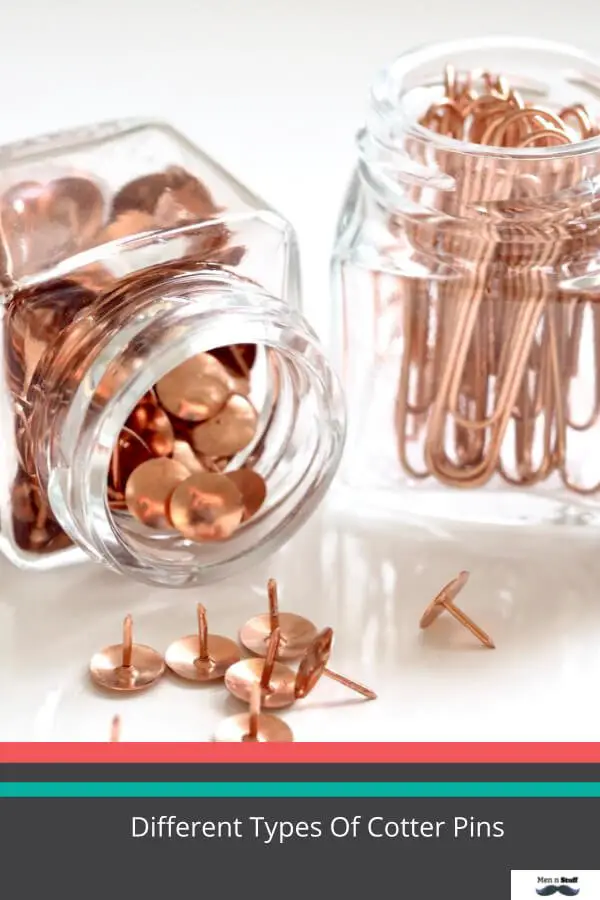Cotter pins come in various types: 1. Split pins, 2. Hairpin cotter pins, 3. Bowtie cotter pins, and 4. R-clip cotter pins. These fasteners are used for securing bolts and axles in various applications.

Different Types Of Cotter Pins
Cotter pins are essential fasteners used to secure bolts, axles, and other components in various applications. They come in several types, each designed for specific purposes. Here are details about different types of cotter pins:
- Split Pins (or Split Cotter Pins): These are the most common type of cotter pins. They have a split end that can be easily inserted through a hole in a bolt or axle and then bent to secure it in place. Split pins are versatile and come in various sizes to accommodate different fastening needs.
- Hairpin Cotter Pins: Hairpin cotter pins are U-shaped pins with a curved body and two straight prongs. They are often used to secure hitch pins, clevis pins, and shafts. The prongs are inserted through a hole and bent over to prevent accidental removal.
- Bowtie Cotter Pins: Bowtie cotter pins have a unique bowtie-shaped design. They are commonly used in agricultural and automotive applications. The wide, flat shape provides added stability and resistance to vibration, making them suitable for securing critical components.
- R-Clip Cotter Pins (R-Pins): R-clip cotter pins are named for their distinctive R-shaped design. They are used to secure hitch pins and shafts and are easy to install and remove. The curved portion of the pin acts as a spring, holding it in place.
- Circle Cotter Pins: These cotter pins have a circular shape with a loop at one end and a straight leg. They are often used in marine applications and as hitch pins. The looped end provides a convenient point for attaching a lanyard or securing the pin further.
- Cotter Rings: Cotter rings are circular rings with one or more prongs that can be inserted into a hole to secure it. They are commonly used in conjunction with clevis pins or other fasteners.
- Extended Prong Cotter Pins: These cotter pins have longer prongs than standard split pins. They provide extra security by extending through more material, making them suitable for heavy-duty applications.
- Toggle Cotter Pins: Toggle cotter pins have a T-shaped design, with a straight shank and a perpendicular prong. They are often used in situations where a strong, secure fastening is required, such as in construction and industrial settings.
- Specialty Cotter Pins: Some cotter pins are designed for specific applications, such as aviation, where safety and precision are critical. These specialty cotter pins may have unique shapes or materials to meet specific requirements.
Difference Between A Cotter Pin And A Split Pin
| Feature | Cotter Pin | Split Pin (Split Cotter Pin) |
|---|---|---|
| Design | Typically has a tapered, cylindrical shape with a single, bent prong. | Straight and cylindrical shape with two separate prongs. |
| Fastening Method | Inserted through a hole and secured by bending the single prong. | Inserted through a hole and secured by bending both prongs apart. |
| Number of Prongs | One prong. | Two prongs. |
| Shape After Fastening | Forms a loop with a single bent prong. | Remains straight with two separate prongs. |
| Stability | Offers less stability compared to a split pin. | Provides more stability due to two separate prongs. |
| Common Use Cases | Often used for securing bolts, clevis pins, and shafts. | Commonly used in various applications to secure fasteners and prevent rotation or accidental disengagement. |
| Variations | May include specialty designs like R-clip cotter pins, hairpin cotter pins, or bowtie cotter pins. | Typically comes in standard, two-pronged design with variations in size. |
What Is A Hammerlock Cotter Pin?
A hammerlock cotter pin is one of the different types of cotter pins. The head and shank are forged to be integral, but they’re not welded together like a full-pinned construction would be. Instead, there’s an open channel that holds the top leg in place by means of a leaf spring or ball bearing inside it (in other words – both legs go through this slot). When you insert the free end into its hole on the opposite side from where you started, it’ll act as if your fingers were giving it a little squeeze: compressing around whatever’s holding it tight enough to keep everything secure without having to use any tools!
What Is A Clevis Pin Used For?
A clevis pin is one of the different types of cotter pins. A cotter pin that has an enlarged head on either end and little or no shank in between, used typically to attach a rope (or chain) to something like a sailboat boom. The round heads are easier for binding lines than, say, the flat ones of other varieties. You can also use them as part of brake systems by combining them with another type – such as spring clips (a nonstandardized term). When you want your brakes acting automatically when you let go at any point along their length, this will keep everything aligned just how it should be without having to pull anything tight manually!
Comparison of Five Types of Cotter Pins
| Type | Design | Use Cases | Stability | Ease of Removal |
|---|---|---|---|---|
| Split Pin (Split Cotter Pin) | Straight with two separate prongs. | Versatile, used in various applications to secure fasteners and prevent rotation or disengagement. | Offers good stability. | Relatively easy to remove by unbending the prongs. |
| Hairpin Cotter Pin | U-shaped with curved body and two straight prongs. | Commonly used to secure hitch pins, clevis pins, and shafts. | Provides stability. | Relatively easy to remove by straightening the prongs. |
| Bowtie Cotter Pin | Unique bowtie-shaped design. | Used in agricultural and automotive applications. Offers added stability and resistance to vibration. | Provides strong stability. | Typically requires tools for removal due to its stability. |
| R-Clip Cotter Pin (R-Pin) | Distinctive R-shaped design. | Used to secure hitch pins, shafts, and other components. Easy to install and remove. | Offers good stability. | Easy to remove by pulling the straight leg. |
| Circle Cotter Pin | Circular ring with loop and prong(s). | Often used in marine applications and as hitch pins. Loop allows for attachment or additional security. | Provides stability. | Requires tools for removal due to the circular shape. |
References:
https://www.huyett.com/all-products/pins/cotter-pins
https://fastenerengineering.com/comparing-five-types-of-cotter-pins/

